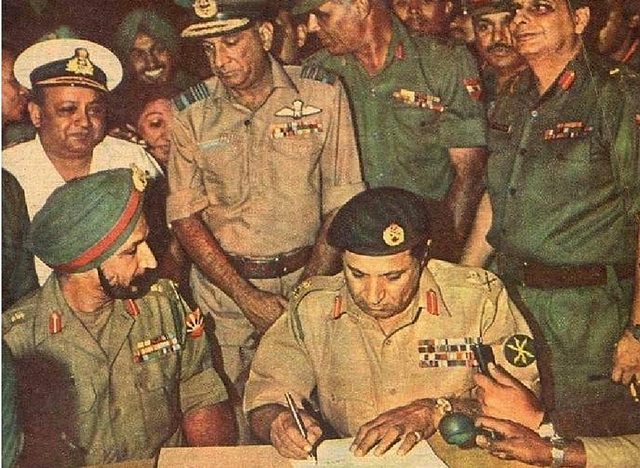
India Could Have Split West Pakistan in 1971
Declassified US records show that India’s objectives during the 1971 Indo-Pak war were greatly curtailed following an instance of high treason committed by a member of Indira Gandhi’s government.
Exactly 45 years ago this day, Pakistan surrendered to the Indian Army and the Mukti Bahini in what was then East Pakistan. But did you know that India’s war objectives in 1971 were greatly curtailed following an instance of high treason committed by a member of Indira Gandhi’s government?
This person, whose identity is most likely known to our government, betrayed India’s “war objectives” to the Central Intelligence Agency in December 1971, prompting the US to arm-twist India into ending the war much sooner than it would have if there was no such betrayal.
In other words, the Vijay Diwas marking the victory in East Pakistan was never meant to fall on 16 December.
In the run-up to the 1971 India-Pakistan war, The New York Times first hinted at the presence of a CIA agent in the Indian government. By December that year, The Washington Post had reported that US President Richard Nixon’s south Asia policy was being guided by “reports from a source close to Mrs Gandhi”.
Records declassified a few years ago show that a dramatic turnaround came on 6 December when a CIA operative leaked out India’s “war objectives” to the agency. Then Prime Minister Gandhi had actually informed her top ministers in a meeting that, apart from liberating Bangladesh, India intended to take over a strategically important part of Pakistan-occupied Kashmir (PoK) and go for total annihilation of Pakistan’s armed forces so that Pakistan “never attempts to challenge India in the future”.
When he came to know of the CIA report, a furious Nixon blurted out that “this woman (Indira Gandhi) suckered us”, for he was under the impression that in their last interaction at Washington, Mrs Gandhi had promised him that India wouldn’t attack East Pakistan―not to speak of targeting West Pakistan and PoK.
The CIA went on to assess that fulfillment of India’s “war objectives” might lead to “the emergence of centrifugal forces which could shatter West Pakistan into as many as three or four separate countries”.
As a direct result of the operative’s information, the Nixon administration went on an overdrive to save West Pakistan from a massive Indian assault.
Records very clearly demonstrate that Nixon then threatened the USSR with a “major confrontation”, should the Soviets fail to stop the Indians from penetrating West Pakistan. Kissinger secretly met China’s Permanent Representative at the UN to apprise him of the CIA operative’s report and rub it in that India’s plan for Pakistan with Soviet backing could turn out to be a “dress rehearsal” of what they might do to China.
All this led to the USSR’s first Deputy Foreign Minister Vasily Kuznetsov visiting New Delhi and telling India “to confine their objectives to East Pakistan” and “not to try and take any part of West Pakistan, including Azad Kashmir”, as “Moscow was concerned about the possibility of a great power confrontation over the subcontinent”. Kuznetsov also extracted a guarantee from Prime Minister Gandhi that India would not attack West Pakistan. This decision was promptly conveyed to Nixon.
On 16 December 1971 when Nixon was told that India had declared a ceasefire, he exulted: “We have made it…it’s the Russians working for us.” Secretary of State Henry Kissinger congratulated him for saving West Pakistan―India’s primary target, as per the operative’s report to the CIA.
In subsequent years, former Prime Minister Morarji Desai, and two deputy PMs―Jagjivan Ram and Y.B. Chavan ― were alleged to be the CIA operative active during the 1971 war.
However, all such charges lacked substantiation; there was no confirmation whether or not such an operative ever existed. As such, no constructive discussion on the issue ever took off. This changed after the release of unassailable US records making it clear that the CIA actually had a “reliable” source operating from inside the Indian cabinet in 1971.
In declassified records, the name of the operative has been censored because the CIA Director has “statutory obligations to protect from disclosure (the agency’s) intelligence sources”. Naming the operative even after so many years will obviously adversely impact the Indo-US relations, and hit the agency’s prospects of recruiting new informants.
The question now arises: Does India know who that traitor was that leaked out 1971 war plan? Former joint director of the Intelligence Bureau Late Maloy Krishna Dhar, no relation of this writer, told me yes.
However, my efforts to get that name officially did not succeed. In 2010, I asked the Prime Minister’s Office whether or not the office had received inputs from the Research and Analysis Wing about the identity of the minister who was said to have leaked information to the CIA during the 1971 war.
I was informed that the inputs from R&AW were exempt from disclosure under the Right to Information Act. To me, it would mean that somewhere in the R&AW archives are lying details of the Indian version of Tinker Tailor Solider Spy. And ours was for real.